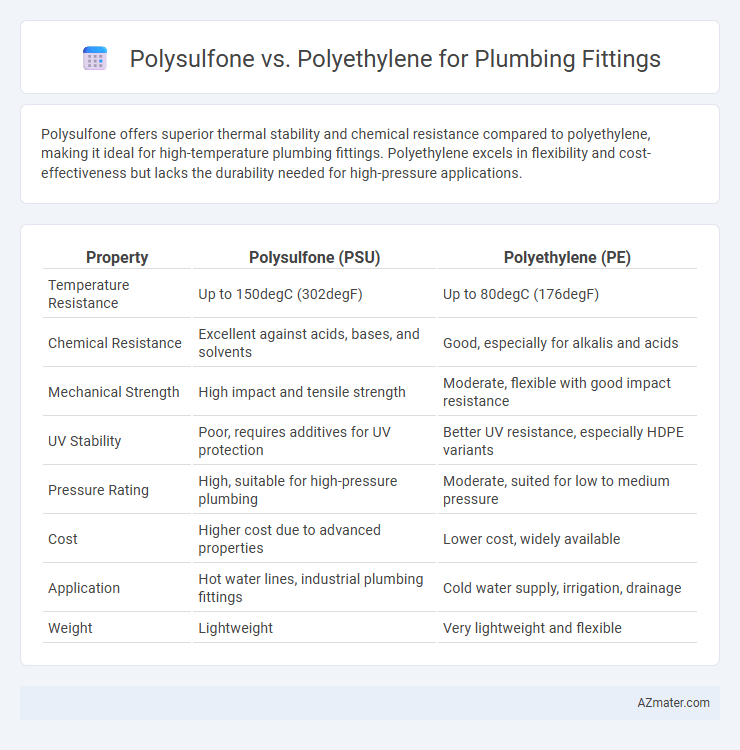Polysulfone offers superior thermal stability and chemical resistance compared to polyethylene, making it ideal for high-temperature plumbing fittings. Polyethylene excels in flexibility and cost-effectiveness but lacks the durability needed for high-pressure applications.
Table of Comparison
| Property | Polysulfone (PSU) | Polyethylene (PE) |
|---|---|---|
| Temperature Resistance | Up to 150degC (302degF) | Up to 80degC (176degF) |
| Chemical Resistance | Excellent against acids, bases, and solvents | Good, especially for alkalis and acids |
| Mechanical Strength | High impact and tensile strength | Moderate, flexible with good impact resistance |
| UV Stability | Poor, requires additives for UV protection | Better UV resistance, especially HDPE variants |
| Pressure Rating | High, suitable for high-pressure plumbing | Moderate, suited for low to medium pressure |
| Cost | Higher cost due to advanced properties | Lower cost, widely available |
| Application | Hot water lines, industrial plumbing fittings | Cold water supply, irrigation, drainage |
| Weight | Lightweight | Very lightweight and flexible |
Introduction to Plumbing Fitting Materials
Polysulfone (PSU) and polyethylene (PE) are prominent materials in plumbing fittings, valued for their durability and chemical resistance. Polysulfone offers superior heat resistance and mechanical strength, making it ideal for hot water systems and industrial applications. Polyethylene excels in flexibility, corrosion resistance, and cost-effectiveness, often used in potable water and low-pressure systems.
Overview of Polysulfone in Plumbing Applications
Polysulfone (PSU) offers excellent thermal stability, chemical resistance, and mechanical strength, making it ideal for plumbing fittings subjected to high temperatures and corrosive fluids. Its inherent rigidity and resistance to hydrolysis outperform polyethylene, ensuring longer service life in demanding water supply and industrial piping systems. PSU fittings maintain integrity under continuous thermal cycling, providing reliability in hot water distribution and chemical processing applications.
Polyethylene: Properties and Uses in Plumbing
Polyethylene offers excellent chemical resistance, flexibility, and durability, making it ideal for plumbing fittings exposed to corrosive environments and variable temperatures. Its low density and resistance to impact enable easy installation and long-term performance in water supply lines, irrigation systems, and gas distribution networks. Compared to polysulfone, polyethylene provides superior resistance to fatigue and cracking, ensuring reliable leakage prevention and maintenance-free operation in residential and industrial plumbing applications.
Mechanical Strength: Polysulfone vs Polyethylene
Polysulfone exhibits superior mechanical strength compared to polyethylene, making it more suitable for high-pressure plumbing fittings. With a tensile strength typically around 75 MPa, polysulfone withstands higher stress and temperature conditions than polyethylene, which generally has tensile strength values between 20 to 30 MPa. This enhanced durability allows polysulfone fittings to maintain structural integrity under demanding mechanical loads and prolonged usage scenarios.
Chemical Resistance Comparison
Polysulfone exhibits superior chemical resistance compared to polyethylene, particularly against hot water, strong acids, and alkaline solutions, making it ideal for demanding plumbing applications. Polyethylene is generally resistant to many chemicals but can degrade when exposed to concentrated acids or oxidizing agents over time. When selecting materials for plumbing fittings, polysulfone offers enhanced durability in aggressive chemical environments, whereas polyethylene is suitable for less chemically challenging conditions.
Temperature Tolerance in Plumbing Systems
Polysulfone offers superior temperature tolerance in plumbing systems, withstanding continuous use temperatures up to 180degC (356degF), making it ideal for hot water and steam applications. Polyethylene typically tolerates temperatures up to 60-80degC (140-176degF), limiting its use primarily to cold water or low-temperature plumbing fittings. The high thermal resistance of polysulfone enhances durability and safety in high-temperature environments compared to polyethylene.
Longevity and Durability
Polysulfone plumbing fittings exhibit exceptional longevity and durability due to their high chemical resistance, thermal stability up to 150degC, and strong mechanical properties, making them suitable for high-pressure and high-temperature applications. Polyethylene fittings, while more flexible and corrosion-resistant, generally have lower temperature tolerance (up to 80degC for HDPE) and may degrade faster under UV exposure or harsh chemical environments. The superior heat resistance and structural integrity of polysulfone ensure longer service life in demanding plumbing systems compared to polyethylene.
Installation and Maintenance Considerations
Polysulfone plumbing fittings offer superior chemical resistance and can withstand higher temperatures up to 150degC, making installation in hot water systems more reliable and reducing the risk of deformation. Polyethylene fittings, being more flexible, are easier to install in complex or tight spaces but have lower temperature tolerance, typically up to 60degC, which may limit their use in certain plumbing applications. Maintenance of polysulfone fittings is simpler due to their durability and resistance to aging, whereas polyethylene requires more frequent inspections for material degradation under prolonged heat exposure.
Environmental Impact and Sustainability
Polysulfone plumbing fittings exhibit superior chemical resistance and thermal stability, leading to longer product lifespans and reduced waste compared to polyethylene. Polyethylene's lower carbon footprint during production stems from its simpler polymerization process and recyclability in closed-loop systems. Sustainable plumbing choices hinge on balancing the durability benefits of polysulfone with the easier recyclability and lower initial environmental impact of polyethylene.
Cost Effectiveness and Practicality
Polysulfone plumbing fittings offer high resistance to heat and chemical corrosion, making them durable but generally more expensive than polyethylene options. Polyethylene fittings provide excellent flexibility and are cost-effective for standard plumbing applications, especially in low to moderate temperature and pressure environments. Choosing between the two depends on plumbing system requirements; polyethylene suits budget-conscious projects, while polysulfone is ideal for demanding conditions requiring long-term reliability.

Infographic: Polysulfone vs Polyethylene for Plumbing fitting
 azmater.com
azmater.com